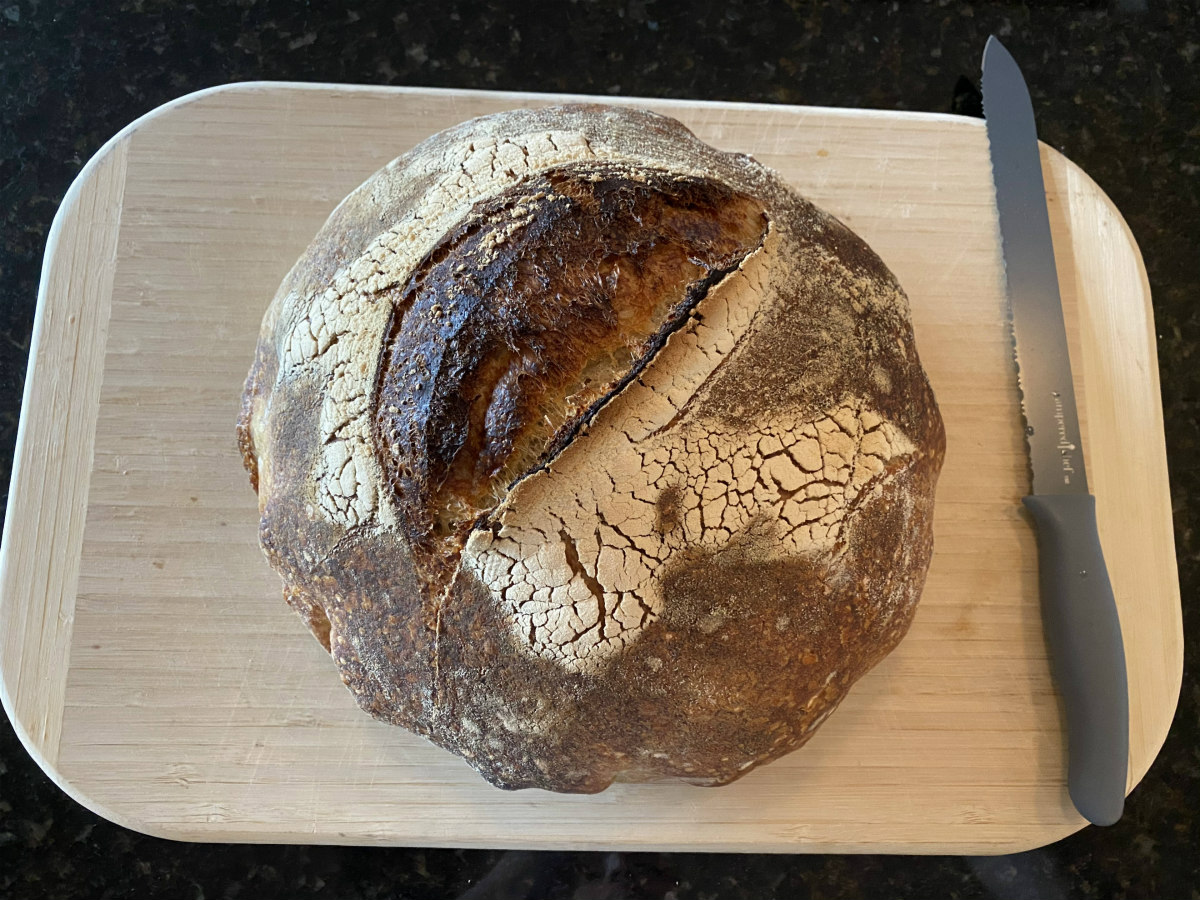I’ll take a wild guess that your Instagram feed started getting cluttered with pictures of people’s beautiful loaves of home-baked bread around the same time mine did.
It felt like about a month ago, everyone I knew (and a lot of people I don’t know) morphed overnight from regular people I liked to people I no longer liked because they also had the secret talent of bread baking.
I was jealous. I did not have the secret talent of bread baking. In fact, in spite of my love of bread — I’d call it a deep, heartfelt appreciation for any levain, really — I had nearly zero talent for baking. I can bake a mean cheesecake. That’s it.
But cheesecake is not bread, and I’ve always relied on our neighborhood bakeries and favorite restaurants to get my gluten fix. In spring 2020 though, that just wasn’t going to happen. So like any enterprising, 42-year-old lady who likes cooking and has a food blog, I decided to bake.
Little did I know that the kind of bread I craved, the kind many of us mindlessly eat and deeply enjoy on the regular at La Buvette, Le Quartier, Farine + Four and Le Petit Paris is the hardest type of bread to make. But cravings are a funny thing. A woman wants what she wants, even when she has no idea what she’s doing.
I decided to live up to my name. I am becoming a Baker.
Loaf one: Google, give me a sourdough bread recipe
If I had to guess exactly what I Googled for that initial loaf, it was probably “sourdough bread recipe.” If you try it (I advise you do not unless you feel very brave) you’ll find thousands upon thousands of “helpful” posts and drawn out tutorials on how to start a sourdough starter at home, what equipment you need, what books you should buy and, if you did try baking sourdough, what in the hell you did wrong.
I realized right away I had a big problem with my whole “I’m becoming a Baker” plan: My pantry had no flour.
I spent two days stalking my Shipt shopper (I really like Shipt, but that’s another post for another day.) Eventually, he dropped a bag of coveted King Arthur flour at my door, and I began my starter.
A starter takes several days for an initial ferment, and I diligently fed mine, which I named Prince Rogers Nelson, for about a week, until he seemed fairly bubbly and somewhat active. But whatever, I wanted to get this baking party started.

I diligently followed the directions I’d printed out from Google. All seemed well. From start to finish, I spent about a dozen hours on those first two loaves. I couldn’t wait for the first bite.
All was not well.
The bread I had imagined dragging through a mound of baba ganoush, or topping with a piece of good cheese, or spreading with a thick knob of salted French butter?
I risked breaking a tooth to bite it, or busting my brand new bread knife while trying to cut it. When I did try, shards of crust zinged around my kitchen. It didn’t rise. It vaguely resembled a kidney bean in shape. It had a blackened bottom. It sucked.

Ever the optimist, I put the bread in a Ziplock once it cooled and thought something magical might happen overnight and I’d be able to eat it the next day.
Wrong. If anything, it finished its transformation into a prehistoric rock inside its plastic cave.
I’d also been confident enough to share my first foray into baking on social media, which means that yes, I posted that terrible loaf on Twitter.
I spent the rest of the week suffering the pangs of defeat and replying to lots of readers’ laughing emoji responses to my posts. I decided to try again. But this time, I called in backup. I left social media behind. A ball of dough would not bring me down.
Loaf two: the education
“What does it mean when your sourdough bread you worked on all day comes out flat?” my first text to Ellie Pegler, master baker at Farine + Four, reads. “Probably means you should just buy bread.”
“No! Keep going!” she responded. And I thought I was an optimist.
I won’t share the oodles of texts that followed, but suffice to say I had done just about everything wrong.
The first and most obvious one was that I’d completely forgotten I owned a KitchenAid mixer. Ellie patiently helped me develop a new set of instructions for one loaf I could make at home in my own mixer based off the ratios she uses at the bakery.
It could not have been more different than my Google recipe.
For the next three days, I worked through my new set of instructions, which included words I’d never seen before, like “autolyse.” Ever the food nerd, I also spent several hours reading about autolyse.

I could barely wait to take the lid off my dutch oven the morning I baked loaf two. Though I expected failure (see loaf one) I remained optimistic that the gorgeous dome of dough might be hidden under the lid.
Spoiler alert: It wasn’t.
But all was not lost! Loaf two looked better than loaf one. But loaf two had some serious internal issues.

Namely loaf two wasn’t cooked all the way. While the initial slices we tried off the edges seemed good, if way too dense, the center slices had a greyish hue of raw dough and the texture to match.
Matthew and I diligently tried to eat a couple of slices (I ate all of mine, I think out of solidarity; bless him for trying to finish his own) and then loaf two met its maker in the same way loaf one did: in the garbage.
Loaf three: Have a little patience
I had several realizations during my second week of wound licking, namely that my main nemesis (as it has been many times before) was being in a damn hurry. Perhaps I needed to have a little patience, to quote the great poet Axl Rose.
I rushed my starter. A new starter is meant to simmer and bubble for at least a month or so before a would-be baker is to have any expectations. (My kind parents sent me some San Francisco starter in the mail, and I’ll be trying that one in the next few weeks, this time giving it the time it deserves.)
I rushed my dough, even in my mixer. I rushed the time it was supposed to be resting and rising. I rushed through the baking, shaving a few minutes off the time when I thought it looked done in round two. I even cut the loaf before it was cool.
I also realized that the dutch oven I’d been using was half the size it was supposed to be, so even if my bread had the energy to spring up in the oven, it didn’t have the space in my pot to do it.
Then a couple of things happened.

I told my bread fairy godmother, Ellie, about my dutch oven woes.
“I have one I never use any more! You can borrow it,” she responded.
Enter this cast iron giant, which I have nicknamed the cauldron, and which is so large there is no room to store it anywhere in my apartment but in the oven, where it belongs.
Something else happened, too. Prince Rogers Nelson started to party like it actually was 1999.

I didn’t change a single step between loaf two and loaf three other than one thing: I took my time.
I took care in the autolyse. I let the starter sit overnight. I let the dough sit overnight in the fridge. I mixed the dough in my KitchenAid low and slow and let it work three times longer than I did the other two times.
I let the dough sit on the counter in repose for a while before I scored it and slid it into the cauldron. Then I waited some more, wondering: would it work this time?
Spoiler alert: It worked.

The phrase I uttered after I saw loaf three’s springy curve isn’t family-friendly, but I will tell you I did a fist pump with my oven-mitted hand. I let loaf three bake an extra seven minutes, and boy were they worth the wait.

Cutting into loaf three was a distinct pleasure. I took some knobs of butter (Kerrygold, sadly, instead of French) and slathered the slice, which I’d patiently let cool for about four hours beforehand.
I won’t be making Claire Saffitz advanced recipes any time soon, or writing bread blogs, or making the bread for anyone but myself or posting my process on social media. I will still buy bread from all my favorite bakeries, and eat it at all my favorite restaurants.
I am not here to give you a bread tutorial, or to tell you anything about baking — I barely know anything myself, as the last thousand or so words prove.
Here is what I will tell you: cooking, more than yoga or meditation or long walks, is getting me through these strange times. That first bite of bread is beyond what I ever thought I was capable of. It’s worth the time and the failure. It made my first embarrassing loaf seem all the more worth it.
I didn’t bake that loaf, or keep trying, to share it on social media, or to write about it, though I did decide to in the end. I baked it for myself. And that is why, I think, it tasted all the better.

Special thanks to Ellie Pegler for her guidance, patience and giant pot.





6 responses to “Bread in the time of Corona: a tale in three loaves”
Sarah, So fun to read. The best line to me is how cooking and baking is getting you through these times. Next time, maybe slice it warm? I can not imagine letting my bread (many recipes, current favorite—NYTimes No Knead Sourdough—no starter required) sit for 4 hours. Take care!
So glad it turned out!! As I’ve always said we learn from our mistakes!! 🥰
Holey moley, love those big hollows for extra sweet butter. Call me a batard or a crumb for having a boule reading through your bread making pane. It was fun. I was familiar with the magic of autolysis, but didn’t know it had a name. Now I’m wondering about the various traditions for breaking bread.
What a great article! I completely enjoyed reading about your efforts and had more than a few laughs! Really miss reading you and Matthew in the Omaha World Herald but from what I hear, you guys made the right move. Keep on writing and entertaining us!
Sarah, it was such a fun article to read, and it was like reading about my own adventure with the sourdough…. though, I did not get to the successful part yet…. would you please share the recipe and steps you followed to get that spring in the oven..? I would really appreciate it.
Hi Veronica! I can’t share my exact recipe, but there’s lots of good ones online. This guide is the best reference I have found online, and I have incorporated several of these steps into my process to get the “oven spring.” Keep trying! It’s worth the time. https://cooking.nytimes.com/guides/59-how-to-make-sourdough-bread?gclid=CjwKCAjw_LL2BRAkEiwAv2Y3SWjfTva5fW1kS11tJNHi3GwqsjlxddefLtTF-4sZ0c0PNMMfon_VsxoCvDwQAvD_BwE&gclsrc=aw.ds